Blog
April 9th, 2012
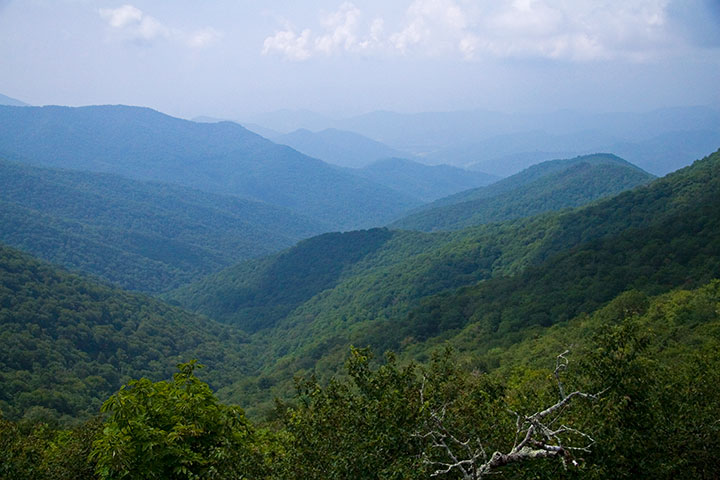
When Jessica and I were in North Carolina last summer, we had just enough sightseeing time to squeeze in a short trip along the aptly-named Blue Ridge Parkway.
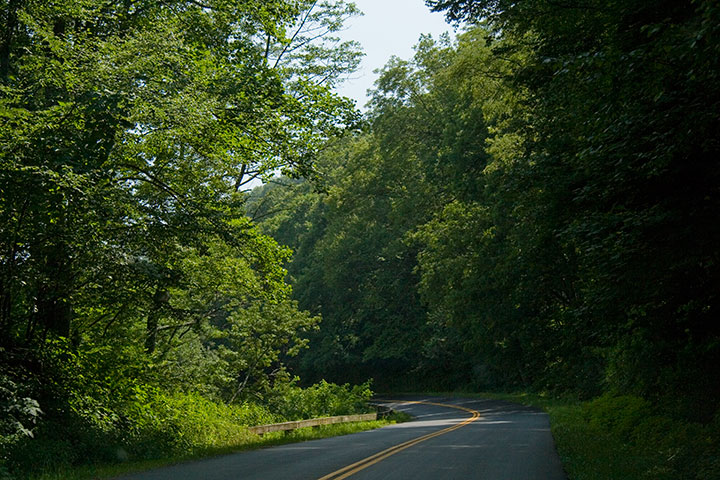
Between the dappled sunlight,
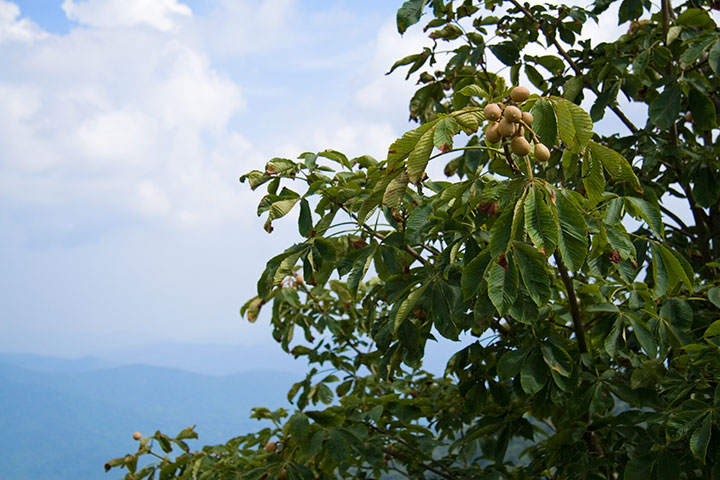
the lush Southern greenery,

and the unexpected splashes of color,

we were enchanted in an instant.
(I, for one, was tempted to do a little Katniss Everdeen impression—just run away from it all and head for the hills.)
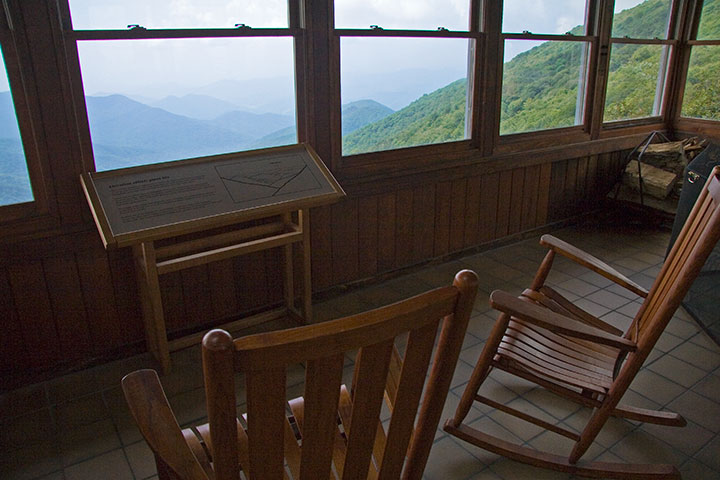
It wasn’t hard to imagine sitting down and breaking out the paper and paints, with all that blue haze as inspiration.
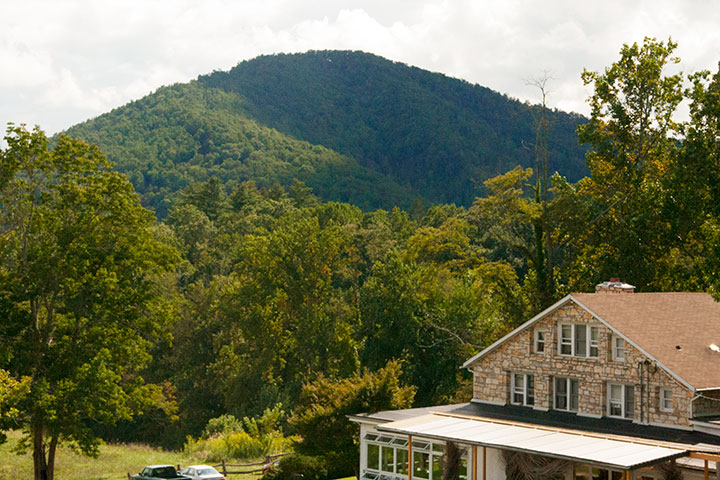
The folks at the nearby Penland School of Craft certainly agree. Since Lucy Morgan founded it in 1929, Penland has become a national center for craft education. Widely respected for its preservation of handcraft traditions, Penland is centered on total-immersion study and both traditional and experimental techniques. Settled in a quiet pocket of the Blue Ridge Mountains, it’s an inspiring setting for focused work. Thanks to its reputation and location, the school attracts some of the country’s best artists and fine craftspeople to study and teach in the Penland studios.
So you can imagine how thrilled and honored Jessica and I were when they asked us to come and teach a letterpress workshop there this summer.
We’ll be teaching a one-week printing intensive, and doing our very best to turn the printshop upside down. This ain’t your grandpa’s letterpress. Here are the details:
Letterpress: Old Dog, New Tricks
A printmaking intensive with Chandler O’Leary and Jessica Spring
Penland School of Crafts, Penland, NC
Summer Session 7: Aug. 26 to Sept. 1, 2012

In the class, we’ll work with both hand-set type (don’t worry, we won’t monkey with any linotype machines…) and photopolymer plates to produce editioned prints that combine the two techniques.
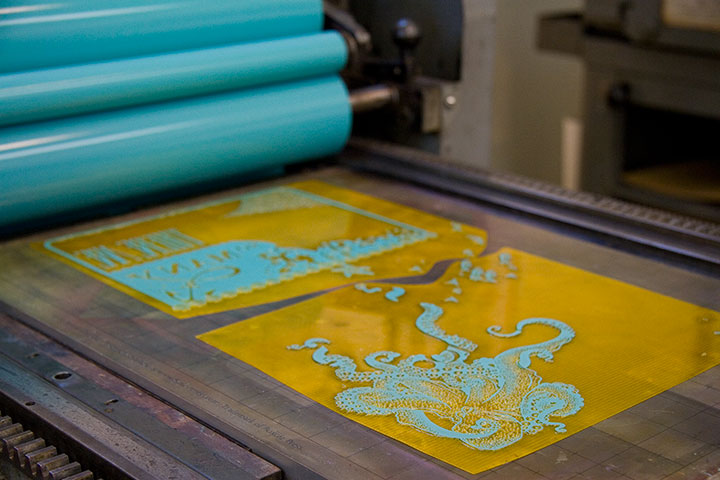
We’re going to get pretty technical, pretty fast, but don’t worry—the workshop is open to all levels of experience. That way we can bring letterpress newbies up to speed quickly, and give more experienced printers the chance to go nuts and geek out with us.
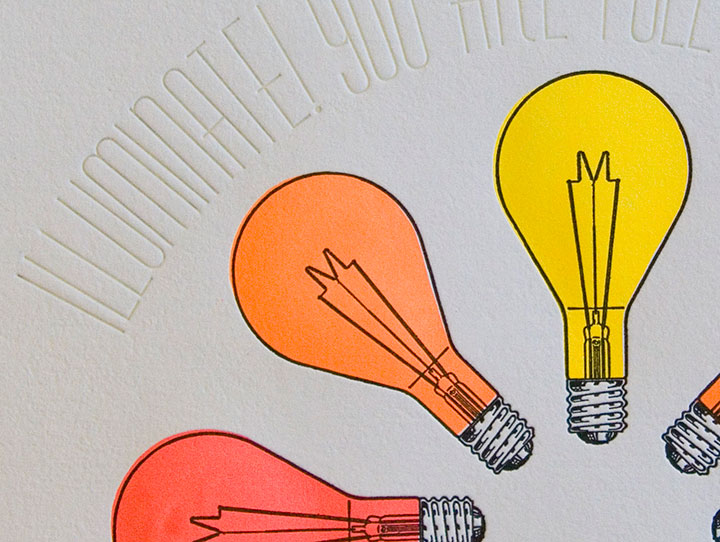
“Unnatural Light” by Jessica Spring
You’ll be doing some death-defying typesetting by hand, using Jessica’s acrobatic techniques,
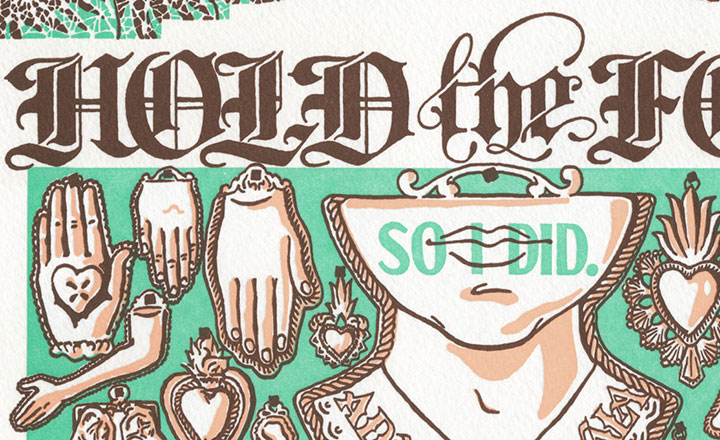
On a Mission Dead Feminist print
and I’ll teach you the ropes of designing for photopolymer, so you can throw a three-ring hand-drawn circus into the mix.
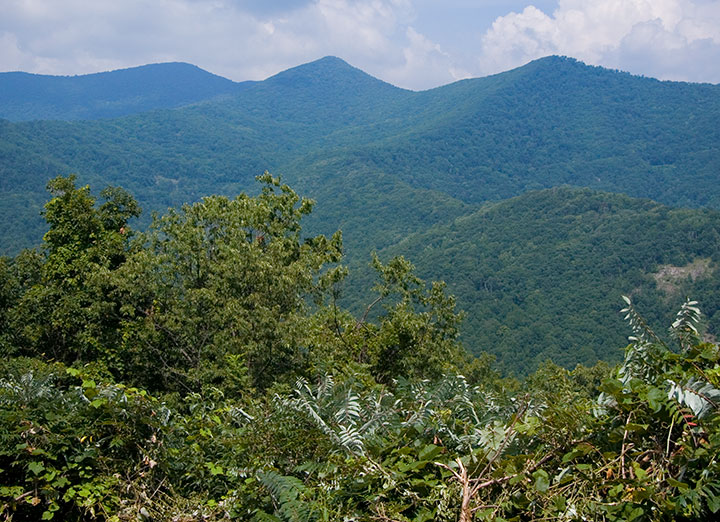
So get thee to the mountains and join us! Registration is open now, but don’t wait too long—the class is capped at 12 students.
See you in North Carolina! Save me some grits, will you?
February 28th, 2012
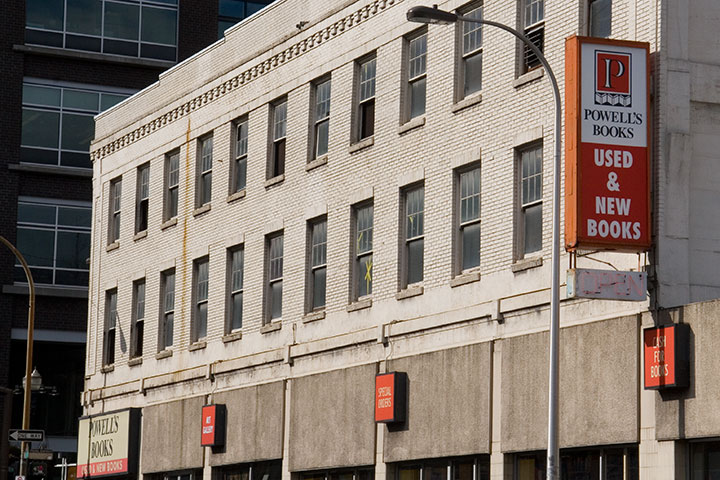
Seeing our stuff for sale at my all-time favorite bookstore makes me happier than I could ever see. If you’re in Portland, or you’re going to be, you can now find Dead Feminists postcards, Lemonade Journals and mini-prints at Powell’s City of Books! Last time I was there I found them in the Red Room.

Rumor has it they’re also in the Orange Room, but Powell’s is crazy-huge and charmingly labyrinthine, so I never did come across them there. Never fear, though: the myriad Info Desk staff are smart and lovely. They’ll point you in the right direction.
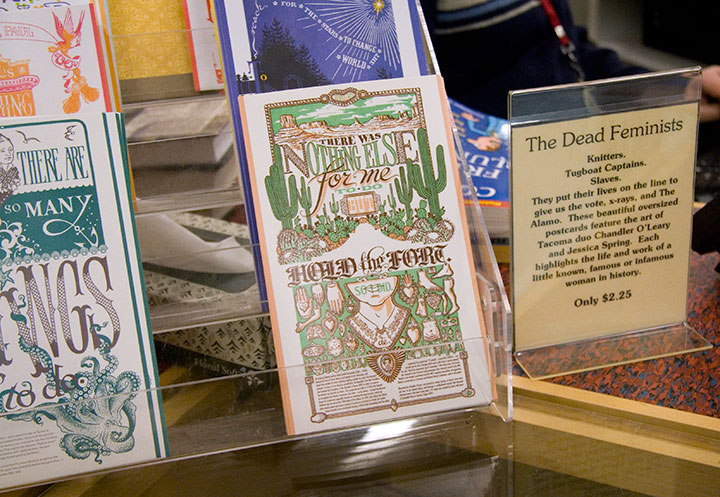
P.S. How cool is the description on that sign? I love these people.
November 15th, 2011
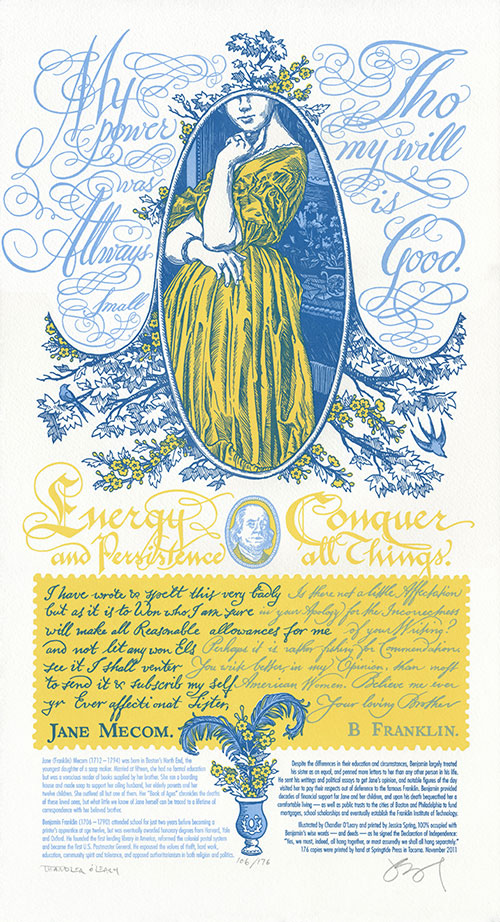
It’s hard to ignore the news of protests, ahem, occupying the attention of cities around the world—of the many and diverse thousands of people unified under one simple, yet infinitely faceted mantra. As members of the, well, vast majority of folks without any real political or financial clout in the world, Jessica and I can get behind their message—but that’s not so much the point. What really amazes us is that with a little tenacity and strength in numbers, the powerless can suddenly become very powerful, indeed.
It made us think of a woman who, despite having a famous sibling, would have disappeared into obscurity but for the simple act of picking up a pen.
My power was allways small tho my will is good. —Jane Mecom
Jane’s eminent brother, on the other hand, had a little more faith:
Energy and persistence conquer all things. —Benjamin Franklin
Jane had both energy and persistence in spades—although we marvel at how she managed it, with twelve kids, a family business and a house perpetually full of boarders to occupy her attention. Yet of Benjamin’s sixteen siblings, Jane is the only one whose story has survived the 200+ years since her death—and all because she committed her thoughts to paper. So in honor of Ben and Jane’s relationship, and in solidarity with those who find the strength to speak up, we present our first dual Dead Feminist broadside, Signed, Sealed, Soapbox.
Since this is also our first print that features a cameo from a male Dead Feminist (nope, you don’t have to be female to be a feminist), we thought it deserved a little something extra. So we set it up like a conversation—or in this case, a written correspondence. Besides, there was just so much historical ground to cover—even condensing the information to a blog post is a challenge, let alone plucking two sentences from a lifetime of dialogue. (If you haven’t already guessed, this post is a long one. Grab a cuppa if you dare to settle in!)
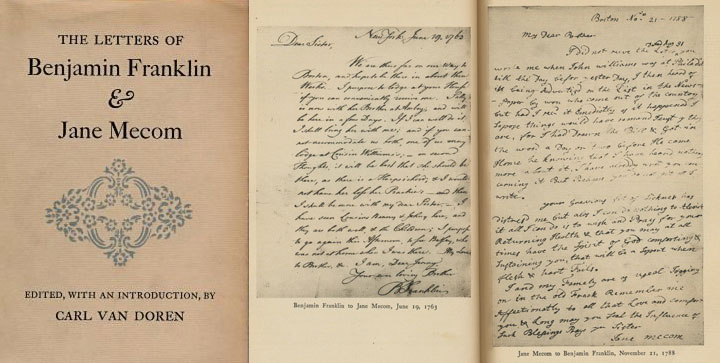
What first sent us down the Jane Mecom rabbit hole was an article about her in the New York Times, written by Jill Lepore. Lepore’s words sent me searching for more information, and I found it buried in the stacks of my local public library. I uncovered an obscure tome: The Letters of Benjamin Franklin and Jane Mecom, by Carl van Doren. The book chronicles their entire surviving correspondence—98 letters in all, printed in full. I was a little worried that the writing style of the day would make even skimming for quotes a chore—but in truth, I couldn’t put it down. It was like peering into the lives of any two ordinary people who happened to care for each other very much. There’s humor, and worried advice, and gossip, and gentle sarcasm, and the occasional scolding (usually on Jane’s part) when one or the other let too much time pass between letters. Most of all, there’s love—it’s there on every page. After all of that, we couldn’t just limit the broadside to a couple of one-liners. So the quotes are accompanied by excerpts from their actual letters, each calligraphed as closely as possible to Ben and Jane’s actual handwriting. Even the spelling errors and colonial-era grammar are intact; we figured it was better not to mess with history.

Jane’s excerpted letter:
I have wrote & spelt this very badly but as it is to Won who I am sure will make all Reasonable allowances for me and will not let any won Els see it I shall venter to send it & subscrib my Self yr Ever affectionat Sister, Jane Mecom.
Ben’s reply:
Is there not a little Affectation in your Apology for the Incorrectness of your Writing? Perhaps it is rather fishing for Commendation. You write better, in my Opinion, than most American Women. Believe me ever Your loving Brother, B. Franklin.
There are few Founding Fathers more famous than Ben Franklin, but Jane was somewhat of a mystery. What we do know is that she had a very different life than her illustrious brother. Thanks to the simple fact of having been born female, her youth was spent having babies rather than obtaining an education. Her life was marked with misfortune, poverty and the deaths of nearly everyone she loved. Yet through it all she craved knowledge, and read everything she could get her hands on. She was a skilled craftsperson, making the famed Franklin Crown Soap and teaching the trade to others. And she followed her brother’s career with pride—and he supported her in return, both financially and emotionally.
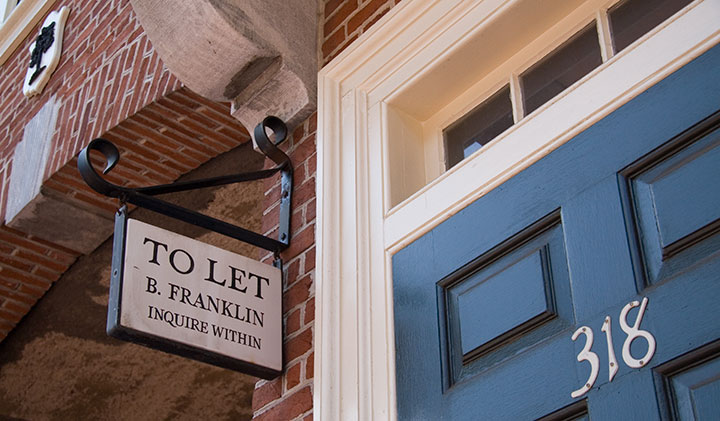
The Tailor and I spent time in both Boston and Philadelphia this summer—ye olde stomping grounds for Doctor Franklin. I had the library book of letters with me on the trip, so their words lent an interesting depth to our wanderings.
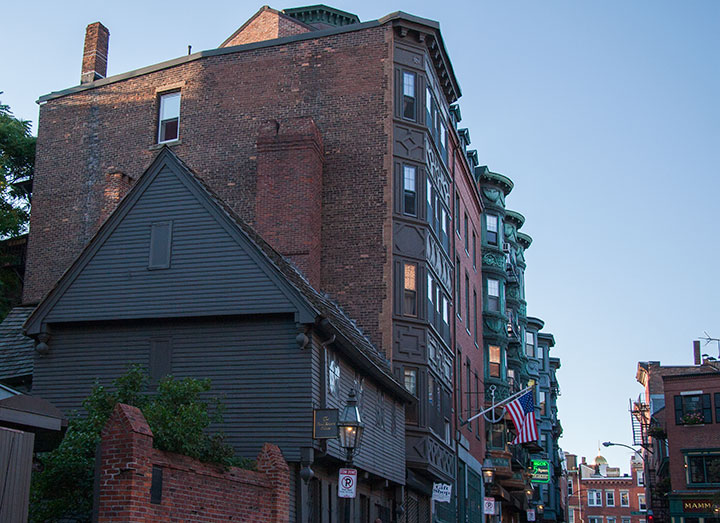
Boston is one of my hometowns, so it was there that I did the most digging. And it turned out that digging was necessary. Ben’s presence is everywhere in Philly, but in Boston, with so many Revolutionary War heroes to honor there, the Franklin family’s presence is far more subtle. And Jane? Well, she’s almost nowhere to be found.
Almost.
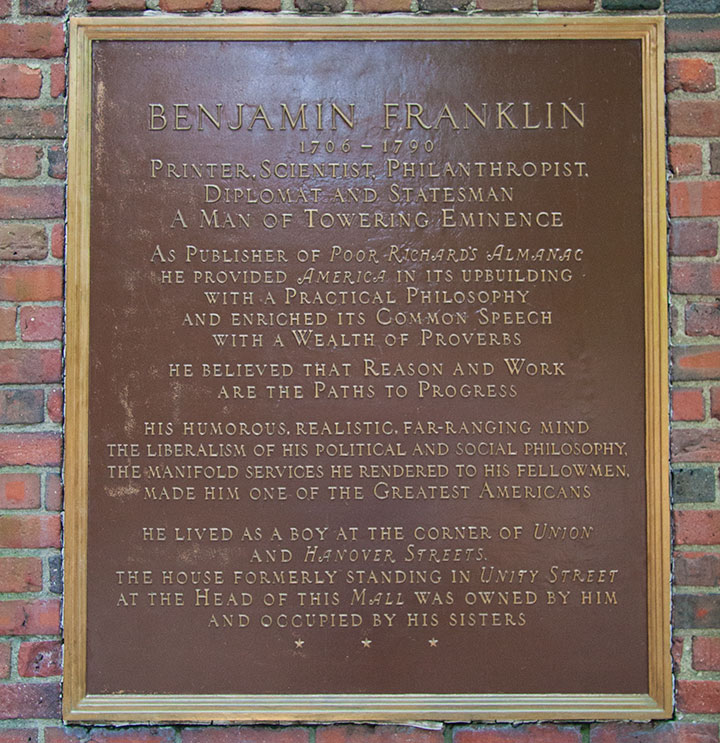
This plaque is all that’s left of the house where Jane spent all her life. It was knocked down to make room for a memorial to Paul Revere. The plaque does mention her briefly, but not by name. Another hazard of being female in the eighteenth century, I suppose.
But Jane lived through the Revolutionary war—in fact, as a resident of the North End, her home was right in the thick of it. In 1775 she fled the British-occupied city and took refuge with friends near Providence, Rhode Island. There, Ben came to rescue her. He took her to Philadelphia, where she spent a year with him before returning to a liberated Boston. While that year was full of turmoil and uncertainty for the citizens of the new United States, 1776 was quite possibly the best year of Jane’s life. For the first time in ages, she could bask in her beloved brother’s company—and he made time for her despite being busy with other things (you know, like founding our country)—and as the honored guest she was largely free from work and family duty.
As far as I can tell, it was also the last time she ever laid eyes on him. Visiting at all was a rare treat—between Ben’s high-profile career and the then-formidable distance between Boston and Philadelphia, it was impossible for them to visit one another more than a handful of times in their entire lives. And since it would have taken weeks for a letter to cross five colonies, and months to traverse the ocean to reach Ben in France, it’s a wonder they remained as close as they did all their lives. Lends a whole new meaning to “snail mail,” doesn’t it?
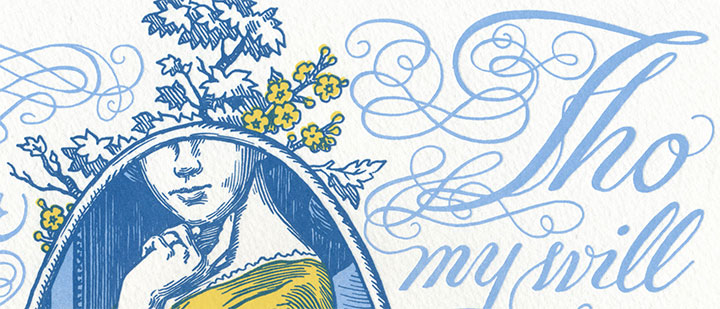
Signed, Sealed, Soapbox is illustrated with the sweeping curves of ornate penmanship and the detailed linework of colonial engravings. A faux-bois forest of branches and flowers resembles the printed toile fabrics of the day. The swoops and swirls of the calligraphy rest in stately Wedgwood blue (complimented by a telltale vase at the bottom!), while Ben and Jane’s correspondence occupies a buttery yellow letter edged like a vintage postage stamp.
And though there is no surviving likeness of Jane Mecom, she deserves so much more than the portrait of a Jane Doe. Instead, she is made in the image of The Comtesse d’Haussonville by French painter Jean-Auguste-Dominique Ingres.

Ben was the best big brother Jane could have asked for. So in honor of his positive influence, we’ll be donating a portion of our proceeds to the Puget Sound chapter of Big Brothers, Big Sisters—an organization dedicated to providing children facing adversity with mentor relationships that change their lives for the better, forever.
• • • • • • • • • • • • • • • • • • • • • • • • • • • • • • • • • • • • • • • • • • • • • • • • • • • • • • • • • • • •
Signed, Sealed, Soapbox: No. 14 in the Dead Feminists series
Edition size: 176
Poster size: 10 x 18 inches
Printed on an antique Vandercook Universal One press, on archival, 100% rag (cotton) paper. Each piece is numbered and signed by both artists.
Colophon reads:
Jane (Franklin) Mecom (1712 – 1794) was born in Boston’s North End, the youngest daughter of a soap maker. Married at fifteen, she had no formal education but was a voracious reader of books supplied by her brother. She ran a boarding house and made soap to support her ailing husband, her elderly parents and her twelve children. She outlived all but one of them. Her “Book of Ages” chronicles the deaths of these loved ones, but what little we know of Jane herself can be traced to a lifetime of correspondence with her beloved brother.
Benjamin Franklin (1706 – 1790) attended school for just two years before becoming a printer’s apprentice at age twelve, but was eventually awarded honorary degrees from Harvard, Yale and Oxford. He founded the first lending library in America, reformed the colonial postal system and became the first U.S. Postmaster General. He espoused the values of thrift, hard work, education, community spirit and tolerance, and opposed authoritarianism in both religion and politics.
Despite the differences in their education and circumstances, Benjamin largely treated his sister as an equal, and penned more letters to her than any other person in his life. He sent his writings and political essays to get Jane’s opinion, and notable figures of the day visited her to pay their respects out of deference to the famous Franklin. Benjamin provided decades of financial support for Jane and her children, and upon his death bequeathed her a comfortable living — as well as public trusts to the cities of Boston and Philadelphia to fund mortgages, school scholarships and eventually establish the Franklin Institute of Technology.
Illustrated by Chandler O’Leary and printed by Jessica Spring, 100% occupied with Benjamin’s wise words — and deeds — as he signed the Declaration of Independence: “Yes, we must, indeed, all hang together, or most assuredly we shall all hang separately.”
Available now in our new Dead Feminists shop!

October 30th, 2011
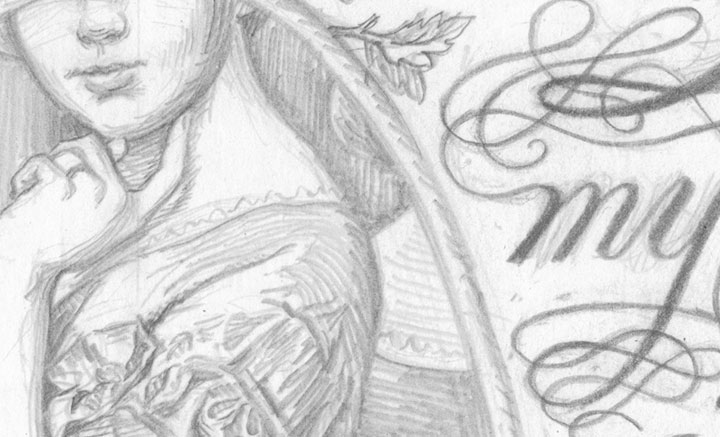
Who is this, I wonder?
You should see the piles of things, er, occupying (hint!) my drafting table this month. You see, Art at Work month is almost here, and I’m scrambling to get ready for all the events coming down the pike.
First up is Studio Tour, that crazy-amazing weekend where it seems like half of Tacoma (the entirely wonderful half, as it turns out) stops by for a visit. This is my third time on the circuit, but our fair city is celebrating its tenth fabulous year of shop crawls and arts extravaganzas. So stop on by next weekend—you can print your own letterpress keepsake (trust me, they’re über cool this year!), pick up free Tacoma swag (better get here early, because it’ll disappear fast), shop for a whole bunch of brand new art and handmade items, and be the first to catch our brand new Dead Feminist, a mystery maiden indeed.
10th Annual Tacoma Studio Tour
Saturday and Sunday, November 5 and 6
10 am to 4 pm, Free!
For more info, full artist list, maps and directions, see here

Look! New stuff!
If you can’t make it to Studio Tour, you can catch a whole bunch of Tacoma artists at the annual Tacoma is for Lovers Craft Fair, put together by the lovely folks at Indie Tacoma and Tacoma is for Lovers. Jessica and I will be sharing a table both days, and it’ll stuffed to the brim with bunly goodness illustrated and letterpress goodies.
Tacoma is for Lovers Craft Fair
Saturday and Sunday, November 19 and 20
11 am to 4 pm, Free!
King’s Books
218 St. Helens Ave., Tacoma
Last but not least, a gigantic virtual heart-shaped thank you to everyone who made a pledge to fund the Apocalypse Calendar! The project is officially a “go,” and we’ll be on press in November. We’re expecting to ship calendars and Kickstarter rewards in early December, and you’ll find calendars in various retail shops this holiday season. If you missed the Kickstarter project, you’ll be able to place online orders here, starting later this week.
Happy Halloween, and see you in November!
October 1st, 2011
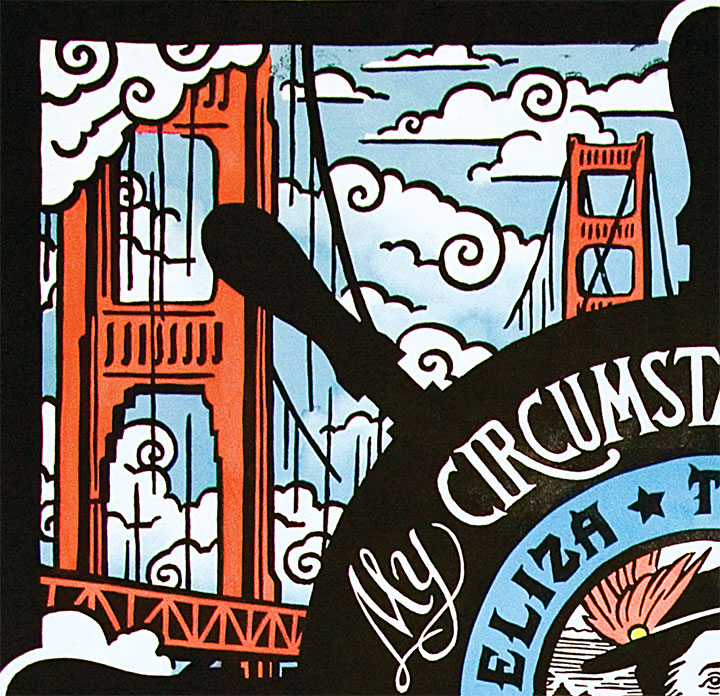
It’s hard to think of a better weekend activity than taking a quick trip to San Francisco.
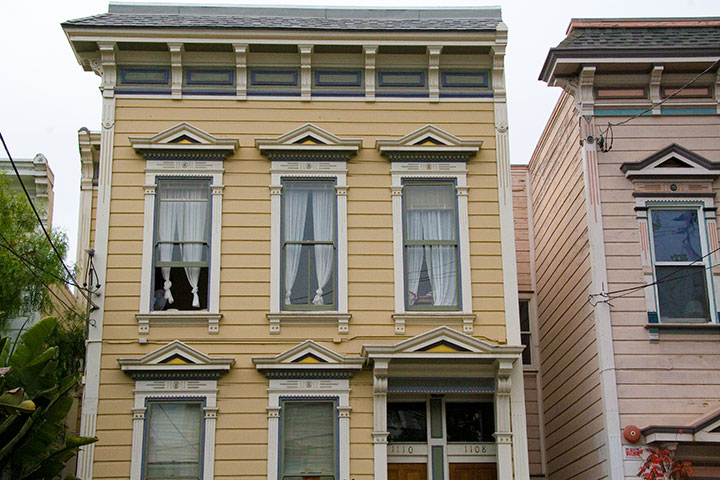
First of all, Jessica and I got to visit the lovely Sarah and Jesse, who live here—
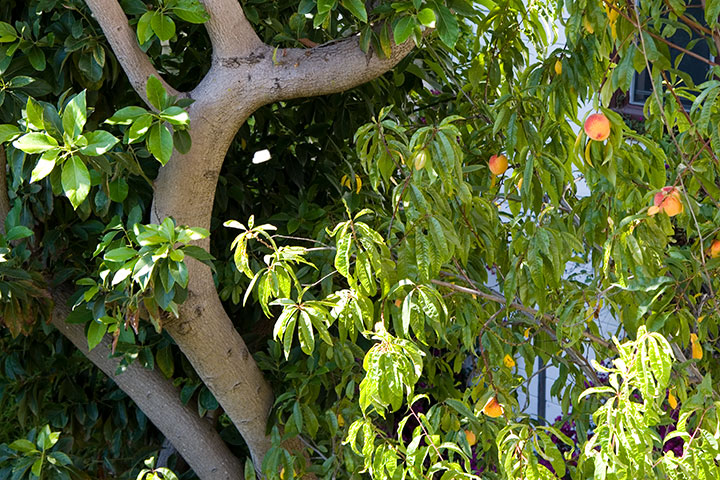
and whose back yard contains this.
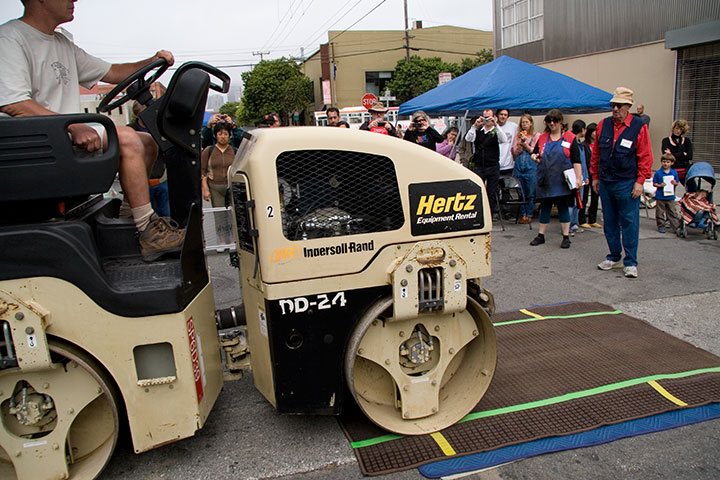
And then we got to raise a fantastic ruckus and make guerrilla street art with a whole bunch of people looking on.
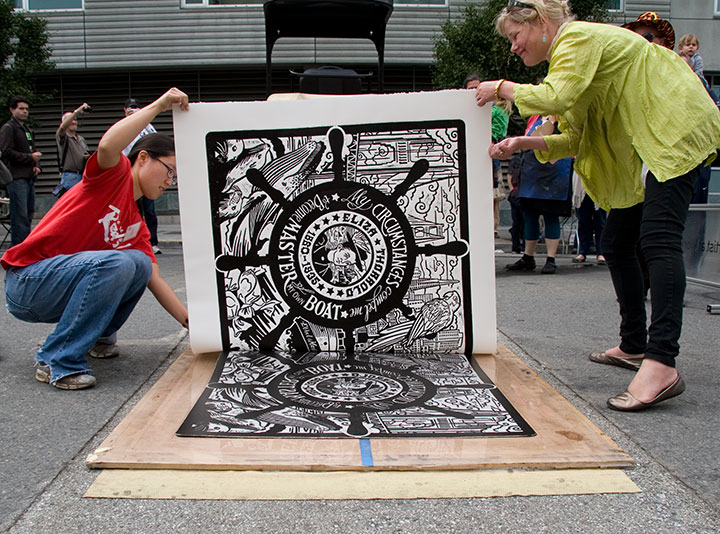
SFCB’s got this thing down to a science. Between the small army of volunteers who took care of the inking and registration (line-up),

and their probably-patented methods for keeping street schmutz off the prints, the results were impressive. In fact, this is my fourth steamroller print (and Jessica’s fifth), and I’ve never seen one turn out this well before.
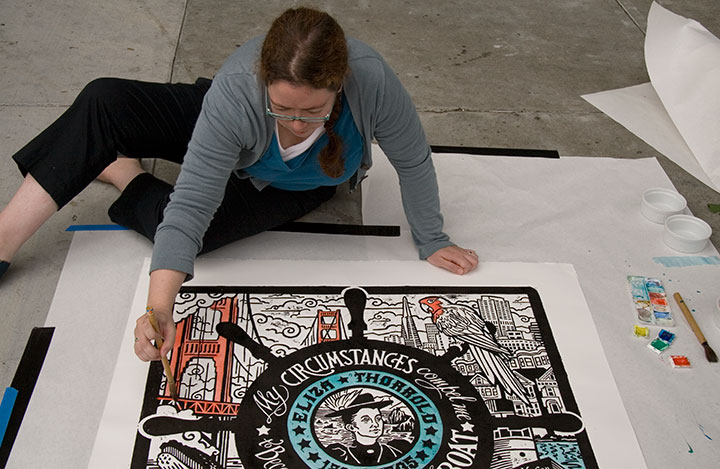
Photos of us by Jesse Mullan
Besides, we really needed to keep our hands clean this time, because we upped our personal ante and just plunked ourselves down on the sidewalk for a bit of on-the-fly hand-coloring (though avoiding the very wet ink felt kind of like playing Twister).
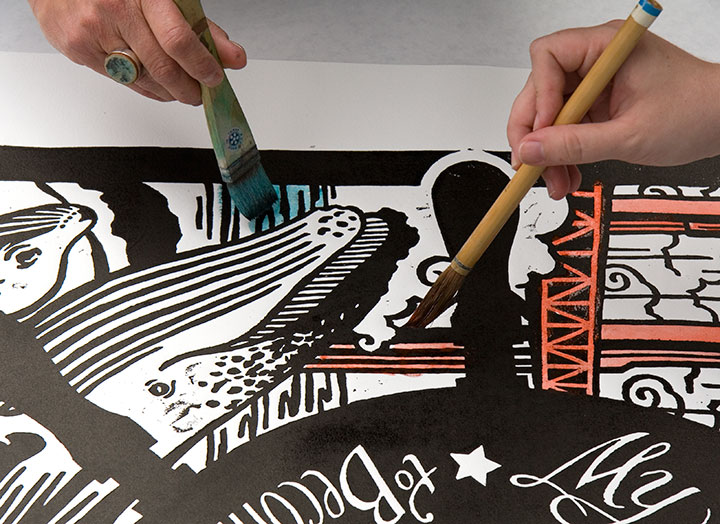
That turned out to be the perfect tag-team job, actually. I do a lot of hand-coloring when I print, as you know, but never anything this big—
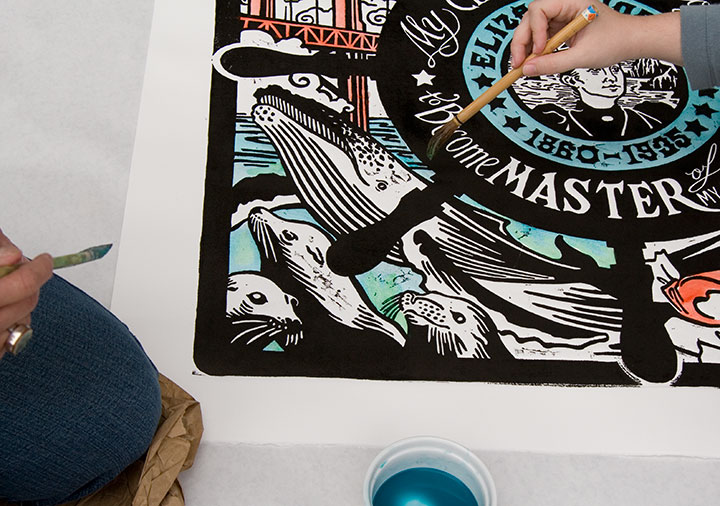
having two sets of hands to blend colors and two sets of eyes to look for missed spots was definitely the way to go.

So thar she blows. Let me introduce you to Eliza Thorrold, and our latest honorary Dead Feminist print, Even Keel. Eliza was the first licensed female tugboat master on San Francisco Bay. After Charles, her husband who piloted the Ethel & Marion before her, died an untimely death, she fought for and received her operator’s license to continue their tug business in his stead and provide for her family. Her quote says it all: “My circumstances compel me to become master of my own boat.” Hear, hear, Eliza.
After she left the high seas and entered retirement as a landlubber, she became master of her own taffy pull by opening a successful ice cream and candy shop with her son. Hence all that salt water taffy. And as if the nautical sweet-shop theme weren’t enough, we couldn’t resist throwing in all our favorite things about San Francisco. So go hunting around the image, and see what you turn up. Then, on your next trip to the City by the Bay, learn more about Eliza’s life (and those of other women mariners) at San Francisco Maritime National Historical Park.
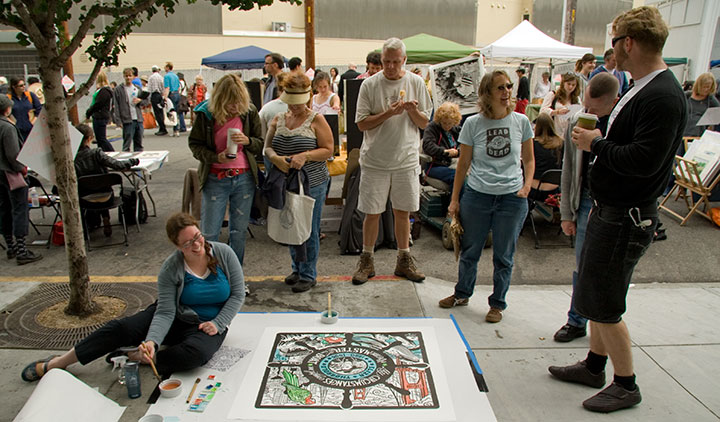
So, yeah. It might not fit the traditional idea of a productive weekend, but it’ll do. We came away with new friends, blue fingertips and a whole lot of ideas to make our own humble little steamroller party better.
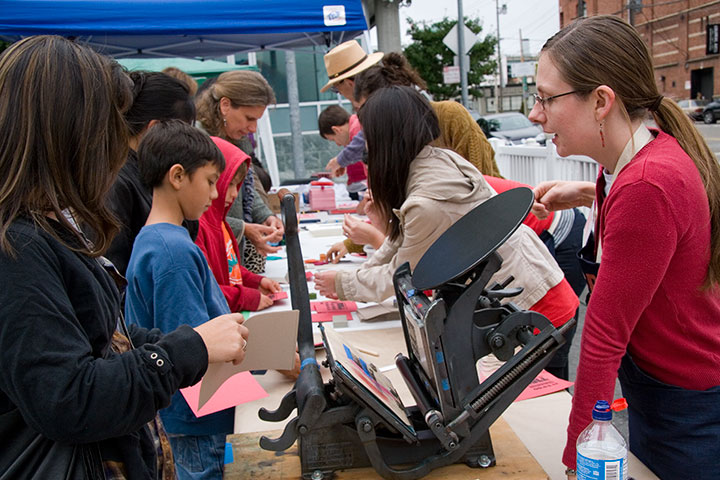
Many thanks to all the staff and volunteers of the San Francisco Center for the Book, who made the day a smashing success—
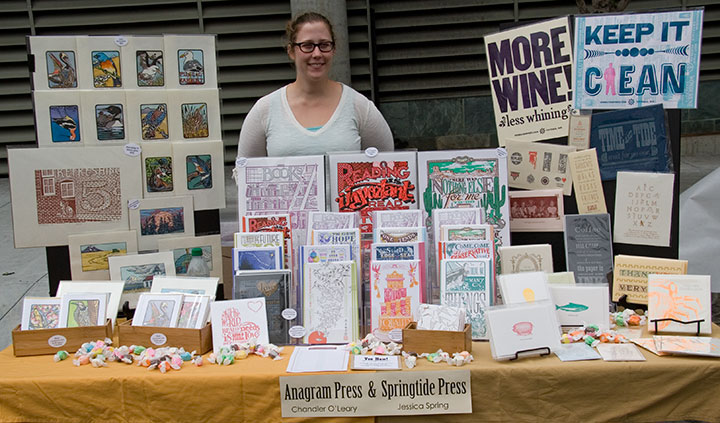
and to all the kindred spirits who lent a whole bunch of helping hands. Like the super-nice TSA employee who took such great care of our linoleum block and didn’t bat an eye that we had to bring something so huge and bizarre onto an airplane. Like Sarah, who manned our table; and Jesse, who shot most of the photos; and the huge, huggable posse of Jessica’s extended family, who helped schlep things and kept us company and bought us beignets. And especially Jessica’s ten-year-old niece, Luciana, who basically designed our table arrangement. ‘Ciani, you’re one awesome ragazza.
And of course, to Eliza—thanks for standing proud at the helm.
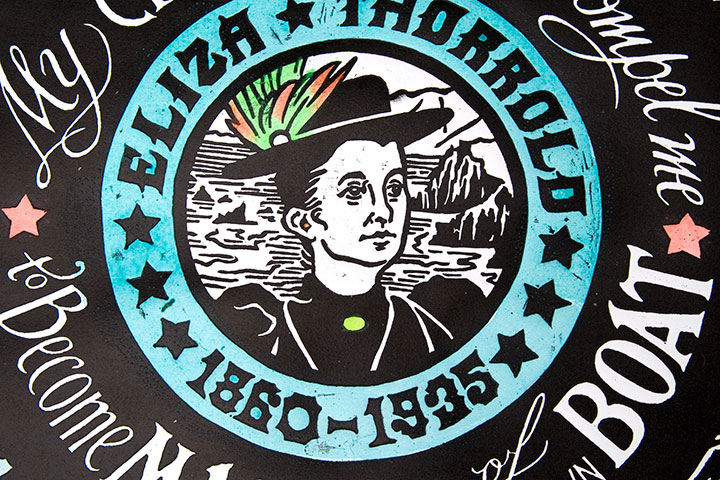
September 22nd, 2011
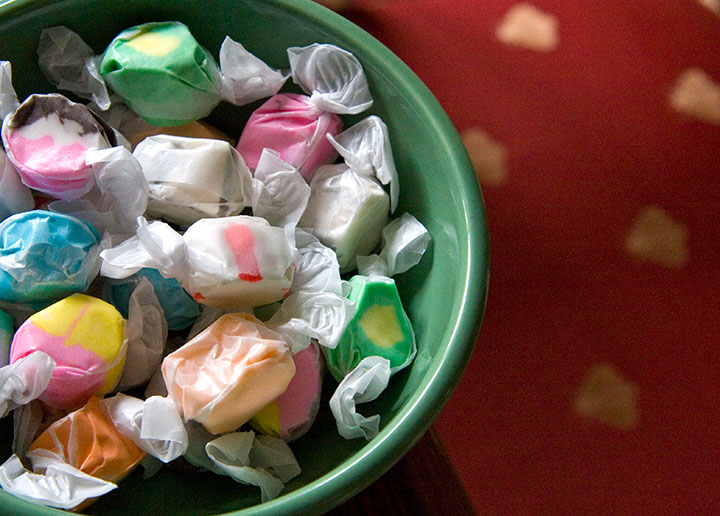
Splurging on a giant bag of salt water taffy is probably a weird way to research a new project, but I swear it’s relevant.
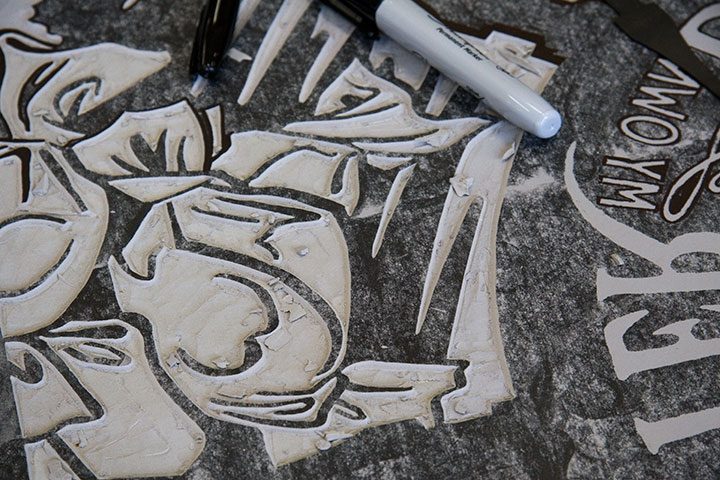
That’s right—Jessica and I are carving again. We’ve been invited by the good folks at the San Francisco Center for the Book (big shout-out to the amazing Rocket!) to be among the featured artist at their eighth-annual Roadworks festival this weekend! Needless to say, we’re super excited.
So if you’re in the Bay Area, swing on by the Potrero and check it out—it promises to be a real hootenanny. The party will be taking up a whole block, chock full of artist vendors, food carts, letterpress demos, and, of course, steamroller printing! And since these guys are rumored to be the original, no-kidding inventors of steamroller printing, they’ll show you how it’s done, for real. Here’s the scoop:
Roadworks 2011
Saturday, September 24
12 to 5 pm, Free!
Hosted by the San Francisco Center for the Book
Rhode Island Street, between 16th and 17th Streets
San Francisco, CA
As a bonus, stick around afterward for a gallery reception for the steamroller prints at 6 pm. There’ll be drinks, music, and a whole lot of loopy artists covered in ink.
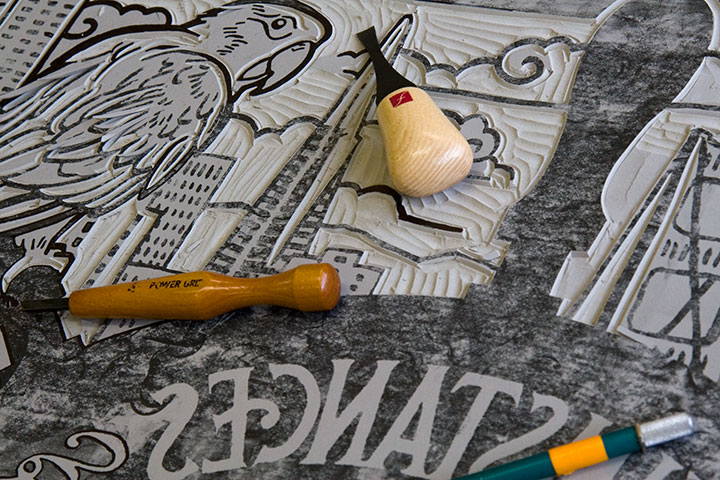
We’ve designed a brand-new, San Francisco-themed, honorary Dead Feminist for the occasion. I won’t reveal who she is until we get back, but here’s a hint: she knew her way around a fo’c’sle and a taffy pull equally well.
And of course, in honor of our muse, we’ll be sharing that salt water taffy at our table. It’s the good stuff, we promise. (Well, we had to sample it, didn’t we?)
See you in San Francisco!
August 11th, 2011
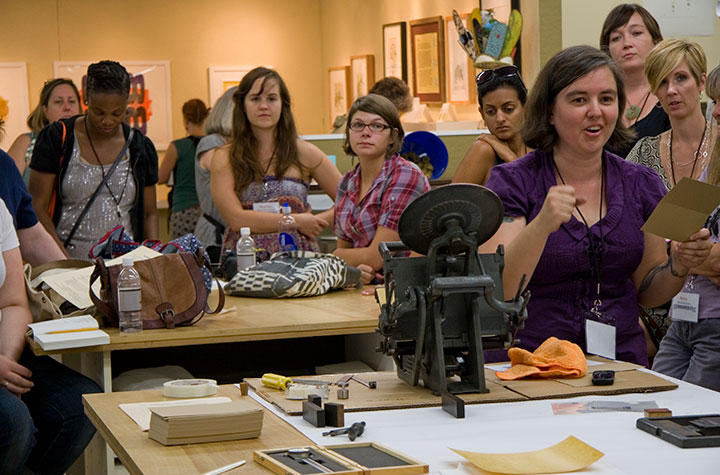
Virginia Woolf said that “a room of one’s own” was essential for women to do creative work—so imagine what 150 women could do with such a room. Jessica and I got to unveil our newest broadside at the first-ever Ladies of Letterpress Conference in Asheville, NC, where we were asked to speak about our series. It was unbelievably inspiring to stand in a room full of heavy equipment—
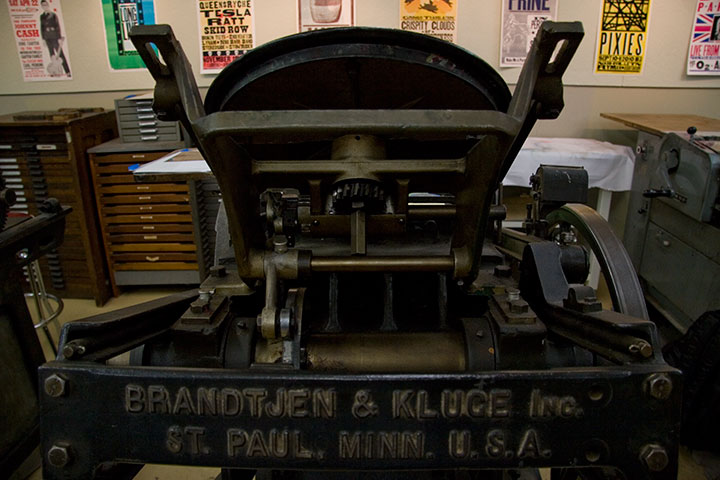
and even more exciting to help our fellow lady printers turn that room into a powerhouse. The conference was a smashing success, and we were both surprised and heartened to discover just how many of us are out there.

The three days of LofLCon were jam-packed with panel discussions, demos and presentations with the most prominent and skilled members of the letterpress community;

an exhibition to introduce us to a vast array of talent;

and a whole lot of hard-won know-how—like when to salvage an old press, and when to hold a funeral. (Sigh.)
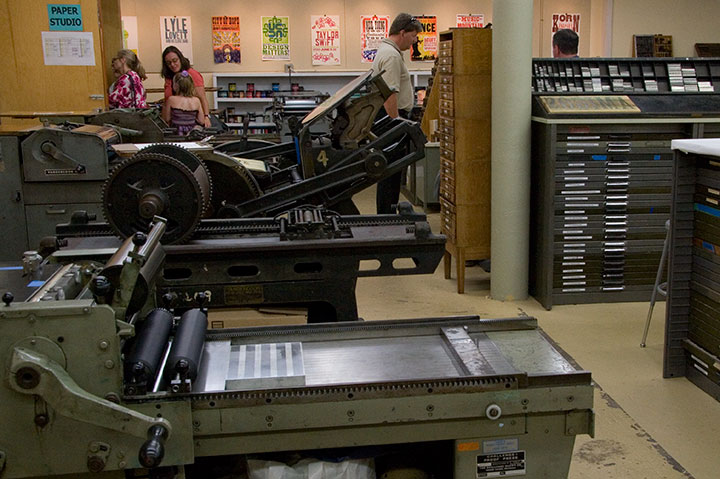
Absorbing letterpress goodness by osmosis was wonderful—
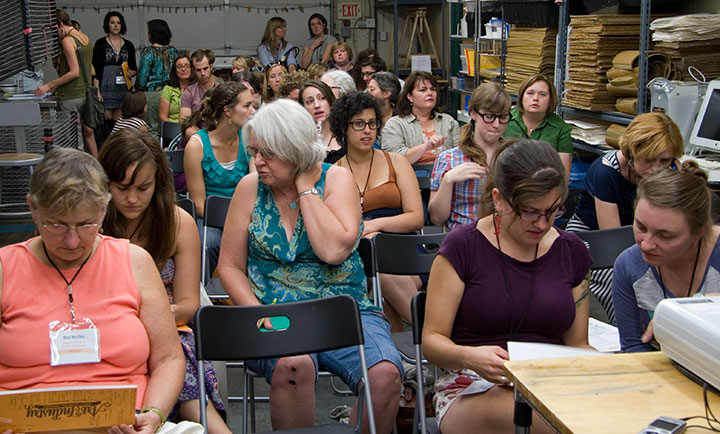
—but the best part was meeting dozens of long-admired artists and brand-new, fresh faces alike.
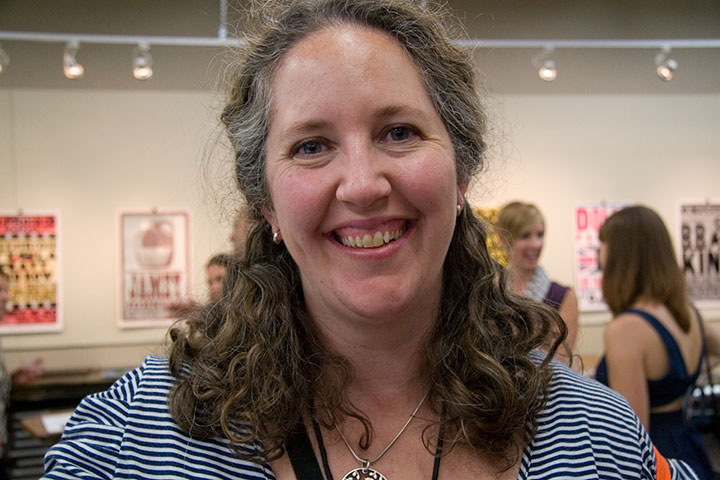
And then there was the joy of running into old friends—look who it is! It’s the lovely Allison from Igloo Letterpress, one of my favorite partners in crime!
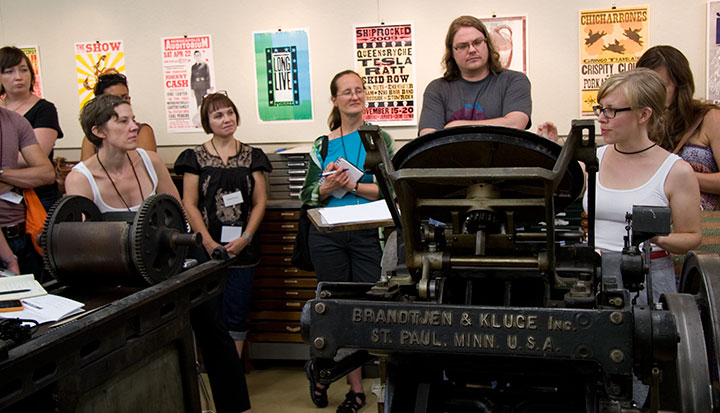
I can’t express enough how excellent the weekend was—Jessica White and Kseniya Thomas (pictured here in white, giving a die-cutting demo on the platen press) deserve a standing ovation for organizing such a fabulous event, and wrangling so many printers to make it happen.
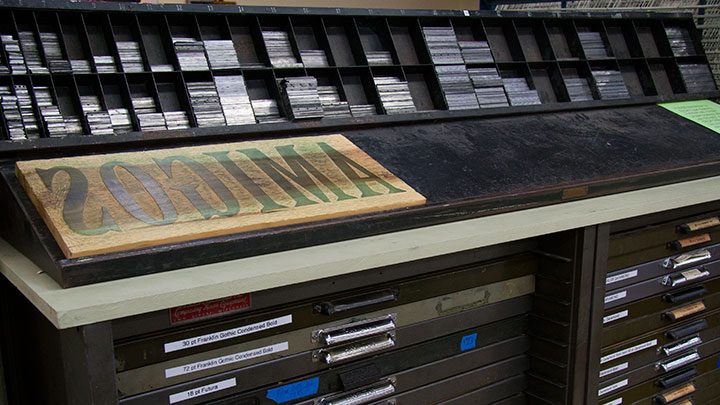
And for those hundred-plus people who shoehorned themselves into that tiny space to attend our Dead Feminists talk, we can’t thank you enough. Your support and enthusiasm for what we do was completely overwhelming—and it was so much fun to be able to get technical with y’all! (Sorry, the accent rubbed off a bit.)
One more thing: I know it somehow didn’t come across in my photos, but we were blown away by the sheer number of feminist fellas who came out of the woodwork and outed themselves as fans of the series. We love you guys—you make us feel like we must be doin’ something right. And thanks to the conference, we’re fired up and ready to get back to work.
August 10th, 2011
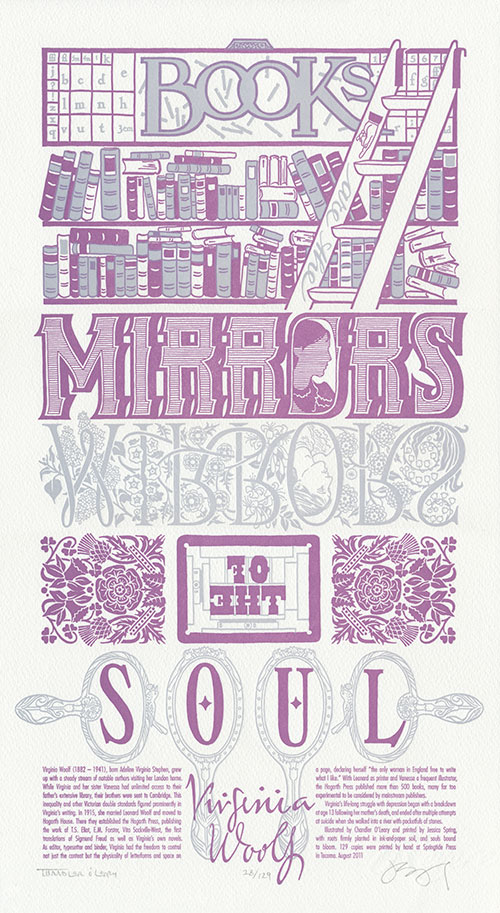
Jessica and I are back from Asheville, with fresh memories of hazy heat and sweltering summer on our minds. Back home in Washington, however, we’re having the kind of chilly summer that demands a cozy sweater, a cup of tea and time spent curled up with a good book (and thanks to our sojourn in the South, we want to do that curling up in a rocking chair!). The news of bankrupt corporate bookstores and dire warnings of an electronic apocalypse swirl around us as we read. Yet the world contained between a pair of unassuming cloth covers begs to differ. The e-readers and tech gadgets of the world are carving out their niche—but we breathe a contented sigh at the simple truth that books are here to stay. In honor of the tactile power of fresh ink and crisp pages, we’ve shared our composing stick with a fellow letterpress printer, the celebrated English author Virginia Woolf:
Books are the mirrors of the soul.
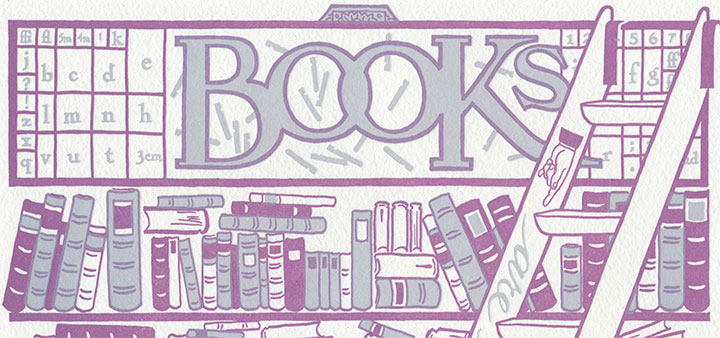
Paper Chase is teeming with letterpress references and the tools of Virginia’s trade. A type case helps sort the problem of minding one’s Ps and Qs, while an inked-up chase (an inside joke for our fellow printers) is locked and loaded and ready to print. Above that is a staple of any writer: a messy bookshelf overflowing with stacked volumes.

Reflected in the mirror of Virginia’s work is the beauty—and sadness—that veils her prose. Ghostly silver ink floats like a lingering afterimage, and an ethereal garden blooms from spectral soil. Lilacs and lilies, thistles and honeysuckles take root—each planting a seed of meaning from the Victorian tome The Language of Flowers. Do a little digging and discover layers of rich symbolism that reveal the woman behind the words.
And for those of you who are into historical printers like we are, there’s an extra little goody hidden in the hand mirrors: a nod to another great Victorian printer and Renaissance-person, William Morris. And if you know your floral national emblems (hint: look for the rose!), you’ll discover a link to both Virginia’s and William’s homeland.

We’ll be donating a portion of our proceeds to the Independent Publishing Resource Center in Portland, Oregon, a non-profit organization that provides individual access to the resources and tools required for the creation of self-published media and art. The IPRC offers workshops, digital technology for writing and design, a research library, and even a letterpress print shop and bindery to aid in the publication of original work.
We think Virginia—and anyone else who loves making an impression—would be proud.
• • • • • • • • • • • • • • • • • • • • • • • • • • • • • • • • • • • • • • • • • • • • • • • • • • • • • • • • • • • •
Paper Chase: No. 13 in the Dead Feminists series
Edition size: 129
Poster size: 10 x 18 inches
Printed on an antique Vandercook Universal One press, on archival, 100% rag paper. Each piece is numbered and signed by both artists.
Colophon reads:
Virginia Woolf (1882 – 1941), born Adeline Virginia Stephen, grew up with a steady stream of notable authors visiting her London home. While Virginia and her sister Vanessa had unlimited access to their father’s extensive library, their brothers were sent to Cambridge. This inequality and other Victorian double standards figured prominently in Virginia’s writing. In 1915, she married Leonard Woolf and moved to Hogarth House. There they established the Hogarth Press, publishing the work of T.S. Eliot, E.M. Forster, Vita Sackville-West, the first translations of Sigmund Freud as well as Virginia’s own novels. As editor, typesetter and binder, Virginia had the freedom to control not just the content but the physicality of letterforms and space on a page, declaring herself “the only woman in England free to write what I like.” With Leonard as printer and Vanessa a frequent illustrator, the Hogarth Press published more than 500 books, many far too experimental to be considered by mainstream publishers.
Virginia’s life-long struggle with depression began with a breakdown at age 13 following her mother’s death, and ended after multiple attempts at suicide when she walked into a river with pocketfuls of stones.
Illustrated by Chandler O’Leary and printed by Jessica Spring, with roots firmly planted in ink-and-paper soil, and souls bound to bloom.
UPDATE: poster is sold out. Reproduction postcards available in the Dead Feminists shop!
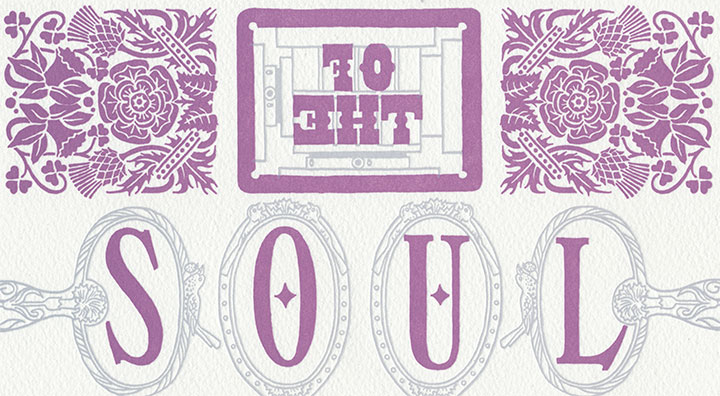
August 3rd, 2011
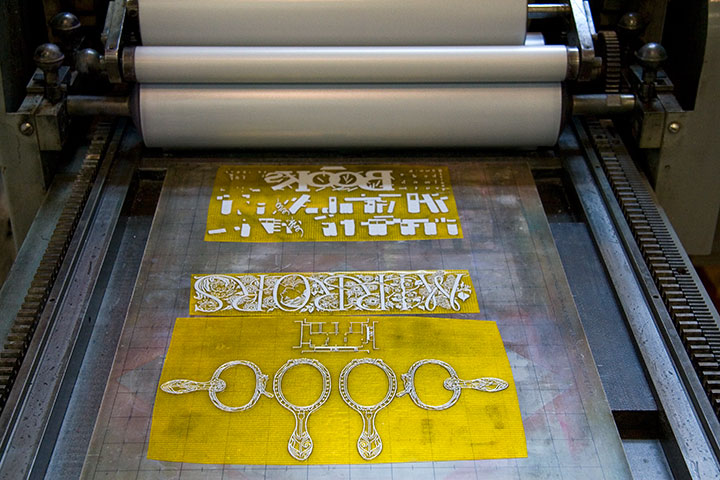
Whew. I’m home from one adventure, but I’m about to turn right around and go off on another. There was just enough time between trips to do a little scribbling, a little scrambling—and maybe a wee bit of nervous screaming as the seconds counted down.
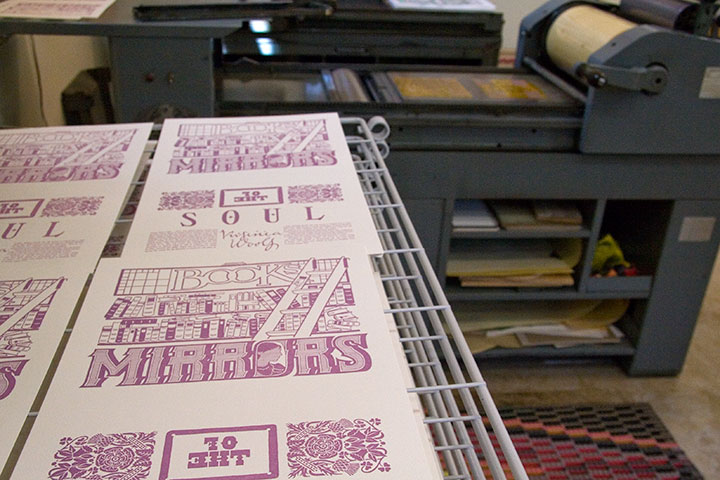
We made it, though—and now, on this summer that’s had me scattered to the four winds, there’s just one compass point left to explore. So Jessica and I are off to Asheville, NC for the first-ever Ladies of Letterpress Conference, finished goodies in hand. When we come back next week, we’ll have a new broadside for you and a whole lot of tales to tell.
Happy trails!
May 30th, 2011
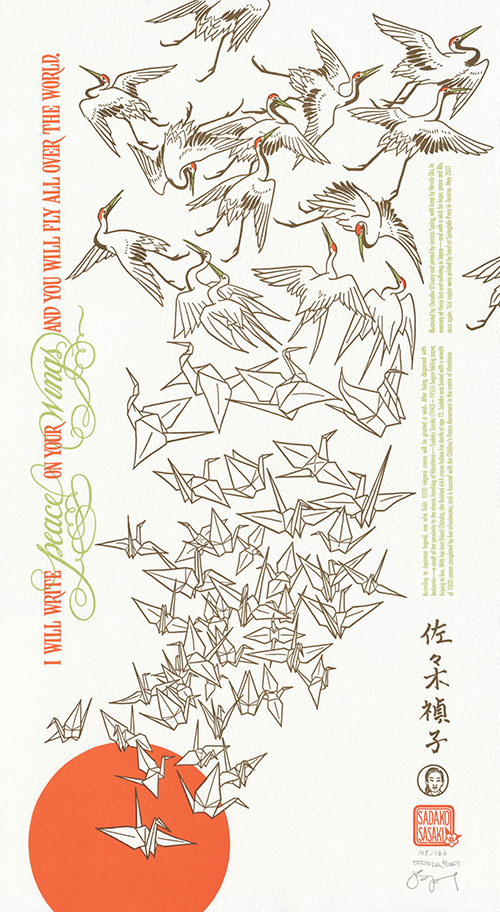
Today is Memorial Day in the United States, a holiday designated for the remembrance of those lost in time of war. But on this day, Jessica and I can’t help but extend our thoughts to others as well, in the spirit of peace. Today our eyes and hearts are trained on the far shores of the Pacific, where the people of Japan are still reeling from the March 11 earthquake, tsunami and nuclear disaster. So for our twelfth Dead Feminist broadside, we remember them by giving wings to the words of our youngest-ever feminist:
I will write peace on your wings and you will fly all over the world. — Sadako Sasaki
As you can probably tell, this piece is a bit of a departure from our usual way of doing things. This time it just didn’t feel right to let the typography run amok, or to fill every inch of real estate with illustrated goodies. So instead, we simply opened the door and let our imaginations take flight. The quote stands quietly apart, running parallel to a flock of origami cranes rising upward from a persimmon sun. As they follow Sadako’s words and wishes, they transform into red-crowned tancho cranes, disappearing off the page.
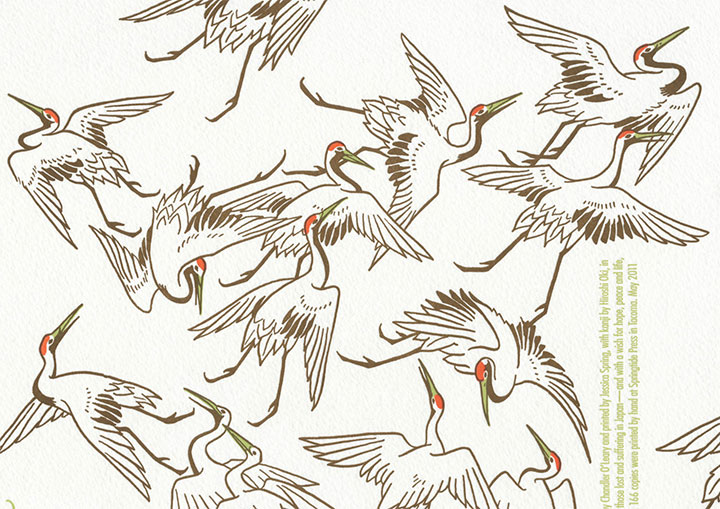
Since the traditions and history of Japanese printmaking are a veritable goldmine, the sky was literally the limit when it came to inspiration. But I had something particular in mind:

On the left is is Cranes and New Year Sun by Utagawa Hiroshige; on the right is Katsushika Hokusai’s famous Great Wave Off Kanagawa. You can see a reference to Great Wave at the bottom of Cranes—making references to both other artists and one’s own older work is a common convention in Japanese art.
I had the good fortune of seeing Cranes and New Year Sun in person earlier this year at the Tacoma Art Museum. Not only is it a beautiful image, it has an interesting quirk that sort of stuck in my craw. See that line running halfway through the composition on the left? The piece is made up of two sheets of paper; it was originally designed to function as the front and rear endsheets of a book. As far as I know, the original viewer never would have seen the image as a whole—and maybe never would have given it a second thought. But together, the two halves of the image form a stunning vertical composition that I wanted to reference for our piece.
There’s also a bit of a practical homage for us here: just as Hiroshige’s illustration is made up of two parts, each one of our Dead Feminist broadsides is also comprised of two halves. For us it’s purely a technical limitation—Jessica’s platemaker can only make plates that are about 8 x 10 inches in size. So since each of our prints is 10 x 18 inches, we have to break the illustration up and print it in two sections: one set of plates for the top, and another for the bottom. So that means that somewhere in every one of our broadsides, there’s a little break running horizontally through the composition. We usually try to hide it as cleverly as possible, or at least blend it in with the overall design, but it’s always there. Take a look at some of our previous prints and see if you can find it. (Mind the gap!)
Anyway, Hiroshige is not the only person we have to thank for all of this. I’d also like to send out a special, winged bit of gratitude to Hiroshi Oki for providing us with his exquisite kanji (Japanese calligraphy) rendition of Sadako’s name—and to his daughter Shiori for introducing us.
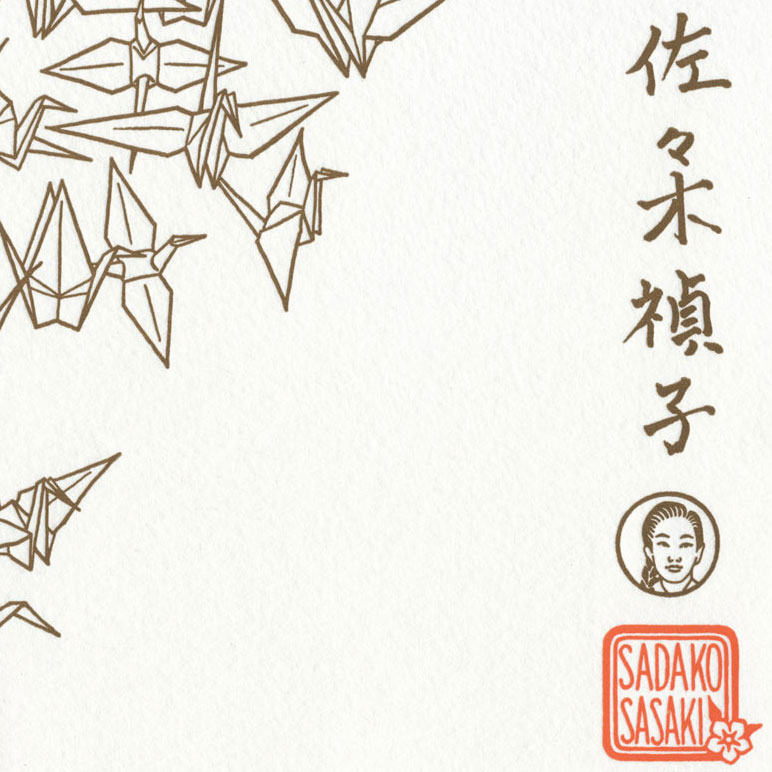
The thing that has just enchanted us both about this project is the very idea of imbuing paper with a wish—of creating something so labor-intensive and time consuming, and then sending it out into the world for a greater purpose. Sadako wasn’t the only person to fold cranes for a wish, but she might be the most well-known. Every year, on the anniversary of the atomic bombing, Sadako’s monument in Hiroshima is festooned with thousands upon thousands of cranes—so many that permanent shelters have been erected there to house and protect them. And even in Western countries, it’s become somewhat of a tradition to give senbazuru (a set of 1000 paper cranes) as a gift to cancer patients. Talk about a ripple becoming a tidal wave.
In that spirit, we’ll be donating a portion of our proceeds to Peace Winds America, a non-profit organization based in Seattle and dedicated to disaster response worldwide. The donation will be directed to the Japan Relief & Recovery Fund, used to rebuild local infrastructure and restore the livelihoods and communities of those affected by the earthquake and tsunami. We’d like to think of this as a little senbazuru of our own.
• • • • • • • • • • • • • • • • • • • • • • • • • • • • • • • • • • • • • • • • • • • • • • • • • • • • • • • • • • • •
Peace Unfolds: No. 12 in the Dead Feminists series
Edition size: 166
Poster size: 10 x 18 inches
Printed on an antique Vandercook Universal One press, on archival, 100% rag paper. Each piece is numbered and signed by both artists.
Colophon reads:
According to Japanese legend, one who folds 1000 origami cranes will be granted a wish. After being diagnosed with leukemia—a result of her proximity to the atomic bombing of Hiroshima—Sadako Sasaki (1943 – 1955) began folding paper, hoping to live. With her best friend Chizuko, she finished 644 cranes before her death at age 12. Sadako was buried with a wreath of 1000 cranes completed by her schoolmates, and is honored with the Children’s Peace Monument in the center of Hiroshima.
Illustrated by Chandler O’Leary and printed by Jessica Spring, with kanji by Hiroshi Oki, in memory of those lost and suffering in Japan—and with a wish for hope, peace and life, once again.
UPDATE: poster is sold out. Reproduction postcards available in the Dead Feminists shop!
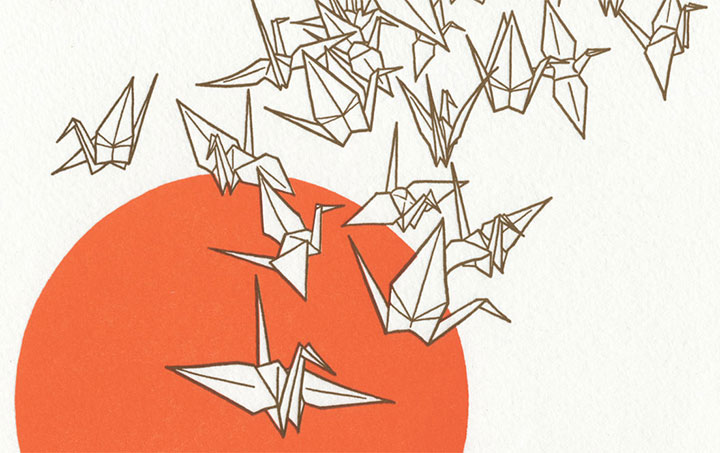

![Chandler O'Leary [logo]](https://chandleroleary.com/wp-content/themes/chandleroleary/images/logo.png)































































